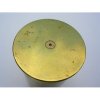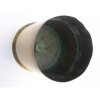Hi all,
Firstly: I've been swamped in work lately, and will contribute later to the thread about Japanese docs. For now though, I did already want to share my latest and greatest acquisition with you guys, for it's a very good one! :tinysmile_fatgrin_t
Last week I was very glad to be able to secure a Meiji era Japanese case after having watched the auction for the entire week, right up to the end.
This Monday it came in, and it's a beauty.
Now, there's plenty of mystery about this case, especially as I have no documentation on such calibres from other eras than the Showa one.
I'm hoping someone can help me properly ID-ing it, as well as perhaps telling me more about its possible usage and some of the headstamp marks.
What I do know:
-The calibre measures out to something like 76.2x104mm, but really it could also be 75x104mm, 76x104mm or 77x104mm.
-The rim measures 84mm.
-From the pictures the case looks cut-down, yet, the brass at the mouth is very thin; certainly thin enough to be likely to not have been shortened.
-The date reads "Meiji 37", which is 1904, and the arsenal mark is the Osaka one.
What I don't know:
-What type of case it is precisely; I cannot find it anywhere on Tony Williams' data calibre pages.
-What calibre it is precisely/officially.
-If it's shortened, or if it's a proper calibre (semi-fixed, perhaps).
-What some the headstamp marks mean that have been marked with a red question mark + number.
Some theories, which are just speculation until confirmed/denied:
I can't discern any crimps or so, but a good length down, on the inside, there's a very pronounced near complete thin 'ring' of green "copper/brass corrosion" all at the same height. It's rather deep down there, so I'm not certain if that means it would have been caused by a driving band having been wedged against it at that position, but who knows... It could perhaps also have been coming from some brass/copper device to perhaps keep a base charge in a semi-fixed case in place, or it could have been caused by something entirely different (like perhaps the case having been filled with water for an extended period of time). Any ideas?
With a seemingly proper length, the calibre would then probably be about one of the four following ones: 75x104R, 76x104R, 76.2x104R or 77x104R. As mentioned, the rim measures at 84mm. When checking Tony Williams' pages on 75mm-77mm calibres there are no possible matches mentioned. On the page about 48mm-74mm calibres, there are a few close matches to cases with a rim of (around) 84mm, very few. If you check: http://www.quarry.nildram.co.uk/ammotable7.htm, the ones that could perhaps be matches if the case was cut-down could be the following ones:
-60x324R, rim: 83mm, countries: Germany, description: 19th century (1891) L/30 field gun
-70x187R, rim: 84mm, countries: Netherlands, description: Krupp L/28 howitzer
-74x150R, rim: 85mm, countries: Belgium, description: howitzer
-74x168R, rim: 85mm, countries: USA, description: sub-calibre training
That last one sounds like a modern one, but as I'm not 100% certain, I left it in. There was also a Russian possible candidate based on the rim, but it's specified as post-war, so I didn't mention it here. Though none of them mention Japan as country, the German one might turn out to be a match. Would anyone happen to have pictures of any of these calibres? Otherwise: would anyone perhaps know if any of these calibres had cases with that typical 'double-rim'?
Finally, I hope someone can tell me some more about this case, and/or identify the unknown headstamp markings (indicated with 5 red numbered question marks) as per the pictures.
Note that there's another mark at the 1 o'clock position of which I don't have a close-up picture yet; I still need to make my own pictures...
Thanks a lot in advance, and enjoy the pics!
Cheers,
Olafo
Firstly: I've been swamped in work lately, and will contribute later to the thread about Japanese docs. For now though, I did already want to share my latest and greatest acquisition with you guys, for it's a very good one! :tinysmile_fatgrin_t
Last week I was very glad to be able to secure a Meiji era Japanese case after having watched the auction for the entire week, right up to the end.
This Monday it came in, and it's a beauty.
Now, there's plenty of mystery about this case, especially as I have no documentation on such calibres from other eras than the Showa one.
I'm hoping someone can help me properly ID-ing it, as well as perhaps telling me more about its possible usage and some of the headstamp marks.
What I do know:
-The calibre measures out to something like 76.2x104mm, but really it could also be 75x104mm, 76x104mm or 77x104mm.
-The rim measures 84mm.
-From the pictures the case looks cut-down, yet, the brass at the mouth is very thin; certainly thin enough to be likely to not have been shortened.
-The date reads "Meiji 37", which is 1904, and the arsenal mark is the Osaka one.
What I don't know:
-What type of case it is precisely; I cannot find it anywhere on Tony Williams' data calibre pages.
-What calibre it is precisely/officially.
-If it's shortened, or if it's a proper calibre (semi-fixed, perhaps).
-What some the headstamp marks mean that have been marked with a red question mark + number.
Some theories, which are just speculation until confirmed/denied:
I can't discern any crimps or so, but a good length down, on the inside, there's a very pronounced near complete thin 'ring' of green "copper/brass corrosion" all at the same height. It's rather deep down there, so I'm not certain if that means it would have been caused by a driving band having been wedged against it at that position, but who knows... It could perhaps also have been coming from some brass/copper device to perhaps keep a base charge in a semi-fixed case in place, or it could have been caused by something entirely different (like perhaps the case having been filled with water for an extended period of time). Any ideas?
With a seemingly proper length, the calibre would then probably be about one of the four following ones: 75x104R, 76x104R, 76.2x104R or 77x104R. As mentioned, the rim measures at 84mm. When checking Tony Williams' pages on 75mm-77mm calibres there are no possible matches mentioned. On the page about 48mm-74mm calibres, there are a few close matches to cases with a rim of (around) 84mm, very few. If you check: http://www.quarry.nildram.co.uk/ammotable7.htm, the ones that could perhaps be matches if the case was cut-down could be the following ones:
-60x324R, rim: 83mm, countries: Germany, description: 19th century (1891) L/30 field gun
-70x187R, rim: 84mm, countries: Netherlands, description: Krupp L/28 howitzer
-74x150R, rim: 85mm, countries: Belgium, description: howitzer
-74x168R, rim: 85mm, countries: USA, description: sub-calibre training
That last one sounds like a modern one, but as I'm not 100% certain, I left it in. There was also a Russian possible candidate based on the rim, but it's specified as post-war, so I didn't mention it here. Though none of them mention Japan as country, the German one might turn out to be a match. Would anyone happen to have pictures of any of these calibres? Otherwise: would anyone perhaps know if any of these calibres had cases with that typical 'double-rim'?
Finally, I hope someone can tell me some more about this case, and/or identify the unknown headstamp markings (indicated with 5 red numbered question marks) as per the pictures.
Note that there's another mark at the 1 o'clock position of which I don't have a close-up picture yet; I still need to make my own pictures...
Thanks a lot in advance, and enjoy the pics!
Cheers,
Olafo
Attachments
Last edited:





